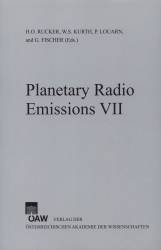
Planetary Radio Emissions VII, pp. 373-380, 2011/12/28
Proceedings of the 7th International Workshop on Planetary, Solar and Heliospheric Radio Emissions held at Graz, Austria, September 15–17, 2010

During solar flares a large amount of electrons with energies greater than 20 keV is generated with a production rate of typically 1036 s-1. A part of them is able to propagate along open magnetic field lines through the corona into interplanetary space. During their travel they emit radio radiation which is observed as type III radio bursts in the frequency range from 100 MHz down to 10 kHz by the WAVES radio spectrometer aboard the spacecraft WIND, for instance. From the drift rates of these bursts in dynamic radio spectra the radial propagation velocity Vr of the type III burst exciting electrons is derived by employing a newly developed density model of the heliosphere. Calculations show that the radio radiation is emitted by electrons with different Vr and therefore by different electrons of the initially produced electron distribution.